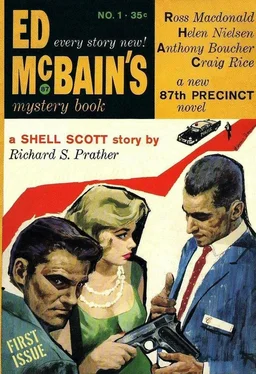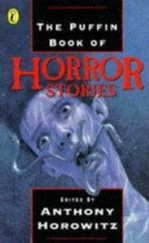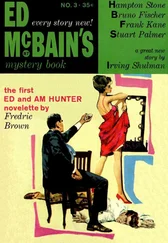Anthony Boucher - Ed McBain’s Mystery Book, No. 1, 1960
Здесь есть возможность читать онлайн «Anthony Boucher - Ed McBain’s Mystery Book, No. 1, 1960» весь текст электронной книги совершенно бесплатно (целиком полную версию без сокращений). В некоторых случаях можно слушать аудио, скачать через торрент в формате fb2 и присутствует краткое содержание. Город: New York, Год выпуска: 1960, Издательство: Pocket Books, Жанр: Детектив, на английском языке. Описание произведения, (предисловие) а так же отзывы посетителей доступны на портале библиотеки ЛибКат.
- Название:Ed McBain’s Mystery Book, No. 1, 1960
- Автор:
- Издательство:Pocket Books
- Жанр:
- Год:1960
- Город:New York
- ISBN:нет данных
- Рейтинг книги:5 / 5. Голосов: 1
-
Избранное:Добавить в избранное
- Отзывы:
-
Ваша оценка:
- 100
- 1
- 2
- 3
- 4
- 5
Ed McBain’s Mystery Book, No. 1, 1960: краткое содержание, описание и аннотация
Предлагаем к чтению аннотацию, описание, краткое содержание или предисловие (зависит от того, что написал сам автор книги «Ed McBain’s Mystery Book, No. 1, 1960»). Если вы не нашли необходимую информацию о книге — напишите в комментариях, мы постараемся отыскать её.
Ed McBain’s Mystery Book, No. 1, 1960 — читать онлайн бесплатно полную книгу (весь текст) целиком
Ниже представлен текст книги, разбитый по страницам. Система сохранения места последней прочитанной страницы, позволяет с удобством читать онлайн бесплатно книгу «Ed McBain’s Mystery Book, No. 1, 1960», без необходимости каждый раз заново искать на чём Вы остановились. Поставьте закладку, и сможете в любой момент перейти на страницу, на которой закончили чтение.
Интервал:
Закладка:
“But you have no idea whether she’s from this city, or out of town, or whatever. Am I right?”
“Yes, that’s right.”
“Davis,” Hawes said, shaking his head. “That’ll be a tough name to track down, Steve. Must be a thousand of them in the phone book.”
“Why is your hair white?” the landlady asked.
“Huh?”
“That streak.”
“Oh.” Hawes unconsciously touched his left temple. “I got knifed once,” he said, dismissing the question abruptly. “Mrs. Mauder, was the girl living alone?”
“I don’t know. I mind my own business.”
“Well, surely you would have seen...”
“I think she was living alone. I don’t pry, and I don’t spy. She gave me a month’s rent in advance.”
Hawes sighed. He could feel the woman’s hostility. He decided to leave the questioning to Carella. “I’ll take a look through the drawers and closets,” he said, and moved off without waiting for Carella’s answer.
“It’s awfully hot in here,” Carella said.
“The patrolman said we shouldn’t touch anything until you got here,” Mrs. Mauder said. “That’s why I didn’t open the windows or nothing.”
“That was very thoughtful of you,” Carella said, smiling. “But I think we can open the window now, don’t you?”
“If you like. It does smell in here. Is... is that her? Smelling?”
“Yes,” Carella answered. He pulled open the window. “There. That’s a little better.”
“Doesn’t help much,” the landlady said. “The weather’s been terrible — just terrible. Body can’t sleep at all.” She looked down at the dead girl. “She looks just awful, don’t she?”
“Yes. Mrs. Mauder, would you know where she worked, or if she had a job?”
“No, I’m sorry.”
“Anyone ever come by asking for her? Friends? Relatives?”
“No, I’m sorry. I never saw any.”
“Can you tell me anything about her habits? When she left the house in the morning? When she returned at night?”
“I’m sorry; I never noticed.”
“Well, what made you think something was wrong in here?”
“The milk. Outside the door. I was out with some friends tonight, you see, and when I came back a man on the third floor called down to say his neighbor was playing the radio very loud and would I tell him to shut up, please. So I went upstairs and asked him to turn down the radio, and then I passed Miss Davis’s apartment and saw the milk standing outside the door, and I thought this was kind of funny in such hot weather, but I figured it was her milk, you know, and I don’t like to pry. So I came down and went to bed, but I couldn’t stop thinking about that milk standing outside in the hallway. So I put on a robe and came upstairs and knocked on the door, and she didn’t answer. So I called out to her, and she still didn’t answer. So I figured something must be wrong. I don’t know why. I just figured... I don’t know. If she was in here, why didn’t she answer?”
“How’d you know she was here?”
“I didn’t.”
“Was the door locked?”
“Yes.”
“You tried it?”
“Yes. It was locked.”
“I see,” Carella said.
“Couple of cars just pulled up downstairs,” Hawes said, walking over. “Probably the lab. And Homicide South.”
“They know the squeal is ours,” Carella said. “Why do they bother?”
“Make it look good,” Hawes said. “Homicide’s got the title on the door, so they figure they ought to go out and earn their salaries.”
“Did you find anything?”
“A brand-new set of luggage in the closet, six pieces. The drawers and closets are full of clothes. Most of them look new. Lots of resort stuff, Steve. Found some brand-new books, too.”
“What else?”
“Some mail on the dresser top.”
“Anything we can use?”
Hawes shrugged. “A statement from the girl’s bank. Bunch of canceled checks. Might help us.”
“Maybe,” Carella said. “Let’s see what the lab comes up with.”
The laboratory report came the next day, together with a necropsy report from the assistant medical examiner. In combination, the reports were fairly valuable. The first thing the detectives learned was that the girl was a white Caucasian of approximately thirty years of age.
Yes, white.
The news came as something of a surprise to the cops because the girl lying on the rug had certainly looked like a Negress. After all, her skin was black. Not tan, not coffee-colored, not brown, but black — that intensely black coloration found on primitive tribes who spend a good deal of their time in the sun. The conclusion seemed to be a logical one, but death is a great equalizer not without a whimsical humor all its own, and the funniest kind of joke is a sight gag. Death changes white to black, and when that grisly old man comes marching in there’s no question of who’s going to school with whom. There’s no longer any question of pigmentation, friend. That girl on the floor looked black, but she was white, and whatever else she was she was also stone cold dead, and that’s the worst you can do to anybody.
The report explained that the girl’s body was in a state of advanced putrefaction, and it went into such esoteric terms as “general distention of the body cavities, tissues, and blood vessels with gas,” and “black discoloration of the skin, mucous membranes, and irides caused by hemolysis and action of hydrogen sulfide on the blood pigment,” all of which broke down to the simple fact that it was a damn hot week in August and the girl had been lying on a rug which retained heat and speeded the postmortem putrefaction. From what they could tell, and in weather like this, it was mostly a guess, the girl had been dead and decomposing for at least forty-eight hours, which set the time of her demise as August 1 or thereabouts.
One of the reports went on to say that the clothes she’d been wearing had been purchased in one of the city’s larger department stores. All of her clothes — those she wore and those found in her apartment — were rather expensive, but someone at the lab thought it necessary to note that all her panties were trimmed with Belgian lace and retailed for $25 a pair. Someone else at the lab mentioned that a thorough examination of her garments and her body had revealed no traces of blood, semen, or oil stains.
The coroner fixed the cause of death as strangulation.
3
It is amazing how much an apartment can sometimes yield to science. It is equally amazing, and more than a little disappointing, to get nothing from the scene of a murder when you are desperately seeking a clue. The furnished room in which Claudia Davis had been strangled to death was full of juicy surfaces conceivably carrying hundreds of latent fingerprints. The closets and drawers contained piles of clothing that might have carried traces of anything from gunpowder to face powder.
But the lab boys went around lifting their prints and sifting their dust and vacuuming with a Söderman-Heuberger filter, and they went down to the morgue and studied the girl’s skin and came up with a total of nothing. Zero. Oh, not quite zero. They got a lot of prints belonging to Claudia Davis, and a lot of dust collected from all over the city and clinging to her shoes and her furniture. They also found some documents belonging to the dead girl — a birth certificate, a diploma of graduation from a high school in Santa Monica, and an expired library card. And, oh, yes, a key. The key didn’t seem to fit any of the locks in the room. They sent all the junk over to the 87th, and Sam Grossman called Carella personally later that day to apologize for the lack of results.
The squadroom was hot and noisy when Carella took the call from the lab. The conversation was a curiously one-sided affair. Carella, who had dumped the contents of the laboratory envelope onto his desk, merely grunted or nodded every now and then. He thanked Grossman at last, hung up, and stared at the window facing the street and Grover Park.
Читать дальшеИнтервал:
Закладка:
Похожие книги на «Ed McBain’s Mystery Book, No. 1, 1960»
Представляем Вашему вниманию похожие книги на «Ed McBain’s Mystery Book, No. 1, 1960» списком для выбора. Мы отобрали схожую по названию и смыслу литературу в надежде предоставить читателям больше вариантов отыскать новые, интересные, ещё непрочитанные произведения.
Обсуждение, отзывы о книге «Ed McBain’s Mystery Book, No. 1, 1960» и просто собственные мнения читателей. Оставьте ваши комментарии, напишите, что Вы думаете о произведении, его смысле или главных героях. Укажите что конкретно понравилось, а что нет, и почему Вы так считаете.












